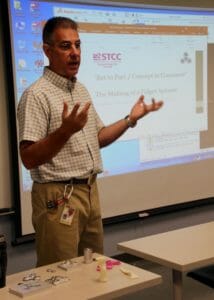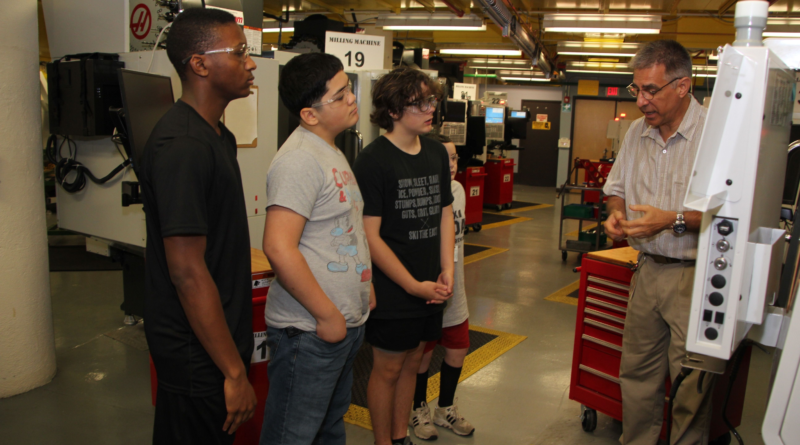Springfield Tech Sparks Interest in Future Machinists
Steven Sinkwich, Staff Assistant at Springfield Technical Community College (STCC) (Springfield, MA), encourages 12 to 17-year-olds, of the job opportunities available to people with CNC skills, with summer machining camp.
The camp project, machining a fidget spinner, had started out only as a fun challenge for himself. After seeing countless fidget spinners in the hands of students, at the check-out counter at the grocery store, and in online advertisements, Sinkwich decided – as machinists often do – to figure out how to make one. “I made one for myself and, just for the fun of it, I sent an email out to just the faculty at the school asking if they had any sons or daughters that would like to attend a class on making fidget spinners,” said Sinkwich. “Well, that blew up into 40 offers.” Soon he was scheduled to hold five classes over the summer, each with around six students.
Each class is only one day long, as the camp is only meant to spark interest with the students. “A 14-year old has an attention span of maybe 15 minutes. So, I have to grab hold of them within that 15 minutes and get them a little bit excited about what they’re going to be doing,” he said. Part of accomplishing that is making a connection to their everyday world.
STCC is located on the grounds of the former Springfield Armory, part of the birthplace of New England machining. The Mechanical Engineering Technology Lab is actually located in the former Gunstock building where the M1 Garand Rifle was manufactured. Sinkwich likes to begin each class by retelling how Thomas Blanchard developed the Blanchard Lathe at the Springfield Armory circa 1819, allowing gun stocks to be made in rapid succession and with interchangeable patterns. Once he has their full attention and interest, he jumps right into machining. Bearing in mind how quickly his students can lose focus, Sinkwich quickly explains the basics of CNC machining and programming before demonstrating how a fidget spinner is made. “It’s basically a turnkey operation, but they get to use the mill to do all the rectangular and square parts and then we use the lathe to turn a couple round parts. They get to see the power of these machines and the intricacy of it. Some of the kids go, ‘Wow I never knew.’ That’s the point. There’s the little spark,” he said.
Sinkwich uses Mastercam® CAD/CAM software (CNC Software, Inc., Tolland, CT) to design and machine the fidget spinners. He explained that he wants his students to be familiar with the most commonly used software because that will best prepare them for their future careers. “It seems like that is what 90 percent of manufacturers are using. I want them to go out and think, ‘Oh, we used that at summer camp.’ I want them to recognize it.” More than that, though, Sinkwich swears by the software’s advanced capabilities. “It lets me visually show them a step-by-step operation of what’s going to happen when they’re at that machine. I get to show them how to face a part or how to do a contour mill. I’m showing them what the tool is actually going to do before they get to the machine. For the kids, it’s eye candy.”

With new students, being able to simulate the machining process is paramount to the learning process. Sinkwich relies on the Verify and Backplot features, which highlight mistakes and possible collisions in a simulation before machining ever begins. “It shows all the mistakes and how to correct them,” he said. “It lets me see how the tools are going to work, and I can even prevent my crashes. When the kids get out there and press a green button, they’re not causing thousands of dollars’ worth of damage.” The functions also saved Sinkwich time and material when he was originally programming the part.
“The spinner is made in several operations. In the first operation, I grab my G54 in the corner of the part. I drill a mounting hole for fixturing, contour the OD, and ream a center hole to be used on my second operation. When I flip the part over, I attach it to a fixture and use a probe to locate the center of the reamed hole as my new G55. Using a probe, the kids can see a bit more automation and blinking lights. Then we move to the lathe where we turn the buttons for the fixture holes and bearing caps.”
He explains the process to his students as the machine runs. “I get to describe how that’s going and I can show them I’m actually controlling my tolerances tighter, especially on the second operation, and sizing the hole for the bearing. Here, if it’s a thousandth of an inch, a fourth of a human hair is too big, the bearing falls through. If it’s a thousandth too small, the bearing won’t go in.” He asks his students to look at the thickness of one of their hairs before telling them that a measurement off by that amount is akin to the Grand Canyon in machining and then shows the difference.
Rather than scaring the students away, those kinds of metaphors seem to only inspire them further. “All the kids want to do when they first come in is grab a spinner and walk out. It’s only when I shock them a little, when they realize how much goes into this part, that they want to do it themselves,” shared Sinkwich. He recalled one young lady who was part of his summer school program when the president of the school came in to watch. “I was showing how to make a spinner for his two kids, and he had a question. She just put her hand up and said, ‘I’ll show you.’ The confidence that she had from that moment was just unbelievable.”
“I had another young gentleman this summer who was actually scared of the machine,” he continued. “I walked him through all the safety features, and all of a sudden, he became more at ease with everything. After the third hour, he had a lot more confidence in himself and the machine. He was opening the doors and putting the part in and closing it and showing everyone what to do. He turned to me and said, ‘My mom would never let me do this.’” When he sees students come alive like that, Sinkwich knows that he’s just created a new machinist.
Sinkwich ends the class by telling his students about the job opportunities that are available to people with CNC skills. Most students are shocked when they learn that they could start in a position at $17 an hour, which is sometimes more than their parents make. As they leave the STCC shop, many students promise Sinkwich that they will be enrolling in a manufacturing program when they graduate high school. “It’s just a STEM introduction. I can’t ask them to become machinists in four hours, but I’m just looking for that spark. I’m looking for them to understand the doors manufacturing can open for them.”
“I opened a can of worms is what I did. It just snowballed,” laughed Steven Sinkwich, Staff Assistant at Springfield Technical Community College (STCC) (Springfield, MA). His summer machining camp for 12 to 17-year-olds had become a hit overnight, and he says that the secret was piquing the kids’ curiosity.
The school will host another summer machining camp in 2020, likely in July or August. For more information, contact the school at (412) 781-7822.

